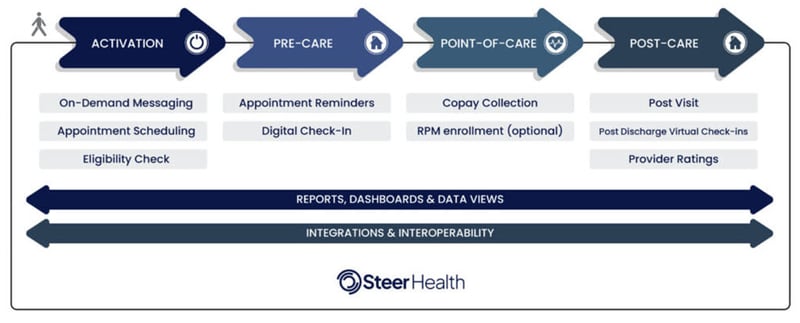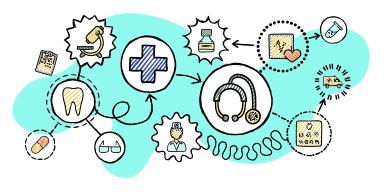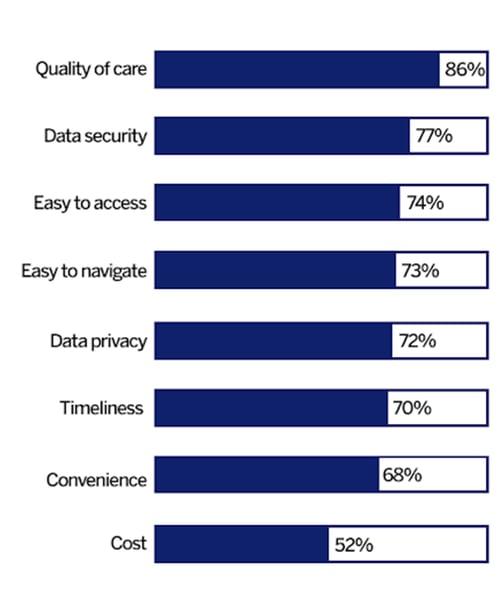How to Grow Your Medical Practice by Improving the Patient Experience
Growing your medical practice while trying to maintain your patient load and standards of care can be overwhelming.
In fact, the odds are heavily stacked against you from Day 1:
- 43% of healthcare businesses fail within their first 5 years (for context, the number is 80% for restaurants)
- An estimated 16,000 private practices have closed their clinics because of COVID-19 (roughly 8% of all practices in the United States)
But it’s not just the ongoing pandemic: From more angles than any time in modern history, medical groups are facing several competitive threats that could jeopardize their future.
Whether it’s multi-billion-dollar tech companies or brand-new healthcare startups experiencing explosive growth, many more entities are entering the provider space.
Add on increasing consumer demand for expanded choice and greater convenience, and you quickly find yourself under immense pressure to take action.
So what can be done to address what seems like an insurmountable battle? How can you grow and scale your existing practice without ignoring the changing landscape of the healthcare industry?
This definitive guide was written to help you understand:
- How patient expectations have changed and where they are heading
- The types of new competitors you face
- The heavy price to pay if your practice fails to meet "modern" expectations
- The actionable tactics you can take to optimize the clinical experience for both your patients and hard-working staff
Let's begin!

Patients Want Convenience, Choice, Self-service, & Transparency
Let’s face it: you’ve worked extremely hard to get to the point where you are today.
You have an existing patient base–possibly that spans multiple locations–that trusts your medical judgment. You have established care options for routinely-faced diseases. And you have built up reliable staff members to keep your practice chugging.
Yet even with patient trust built up over many years, you have to keep up with the times if you want your patients, and your staff, to stay with you.
Put bluntly, they expect things to be “run a certain way” and COVID-19 has single-handedly changed what they want. We are effectively in a market where the patients themselves dictate the evolution of the healthcare industry.
To show you precisely what this means, let’s break down the newly evolved demands of your patients into tangible items.
Instant Appointment Scheduling, Convenience
Your patients want nothing less than the Amazon experience applied to healthcare.
By this, we are referring to how insanely easy it is to use the website and order products. If you’ve ever searched for or purchased anything on Amazon, you already know about the “frictionless experience” they provide:
“If the process of finding a product, selecting the right product, adding it to a shopping cart, designating shipping and payment options, and finally completing the purchase process isn’t accessible from end-to-end, then a customer may find somewhere better to shop. “
So much so to the point where it is more convenient to use Amazon than any other website. You could even go as far as to call this the tyranny of convenience:
“Convenience is a value, and one we hold personally...Ultimately, this is why it keeps winning, outweighing the more abstract ideas like privacy, democracy, or equality, all of which remain merely issues for most of us.”
If your patients don’t feel the exact same way when locating your practice, booking an appointment, or dealing with your clinic, you are easily replaceable by another clinic that will make them feel the way they want to feel.

Multiple Healthcare Choices - In Communication and Care
Digital healthcare has afforded patients the ability to have options in every aspect of their experience.
This includes, but is not limited to:
- Avenues for communication - phone, social media, chatbots, website intake forms, etc.
- Wide selection in care - virtual, in-person, hybrid care
- Easy payment methods - all-at-once vs. paying overtime, different transaction methods, coverage from multiple insurers, etc.
The first bullet point above is especially important: Patients expect to be communicated with by the "channel" they are most used to. They also expect your practice to note their preference and use it in future correspondence.
The ability to capture patient preferences and use those when communicating with them is critical to maintaining a positive patient experience.
Personalizing Their Patient Experience
Consumers are accustomed to self-service options, so as patients, they seek self-service when engaging with their healthcare provider.
The rapid technological advances for helping consumers become more efficient with day-to-day tasks have created a new "standard" of expectations that have transitioned to medical care.
This was blatantly obvious as early as 2013:
“Whether it is self-checkout at the grocery store, paying a bill from a laptop in their living room, or depositing a check through an app on their smartphones, consumers gravitate toward businesses that let them complete tasks rapidly and easily, at their own convenience.
And that’s quickly becoming true in healthcare, where patients are asking providers to provide self-service options for transacting such healthcare-related tasks as scheduling appointments, paying bills and filling out or updating forms.”
...the top pain point among patients is hassling with paper forms and having to answer the same questions repeatedly, along with not having 24/7 access to health information online.
“Simply making it more convenient for patients to get in and do the things they need to do can go a long way toward keeping providers’ satisfaction scores high.”
Several studies and white papers (Self-service technology and patient self-service) are in uniform agreement with this observation, and there’s no turning back.
Digital Reputation: Complete Transparency of the Provider
While many patients still rely on old-fashioned word-of-mouth to hear about new physicians and their practices, the increase in patient autonomy mentioned earlier also applies to discovering exactly who you are.
According to B2B information technology outlet DevProJournal:
“Things like physician reviews, online payment methods, and digital health records are driving patient choices and are providing easy accessibility to their healthcare, which is something patients are not used to.
Patients can use this information to determine whether or not a specific practice is going to serve their needs and what the benefits, drawbacks, differentiations may be between competitors.
The power of choice enables patients to make the best decision for themselves.”
In other words, online reputation management is the first preemptive step you can take in establishing, increasing, and maintaining consumer trust.
Even before a person becomes your patient, their opinion of you and your practice is heavily influenced by independent reviews and ratings they discover, have shared to them, and share with others.
Just take a look at some of these statistics compiled by the American Academy of Family Physicians:
- Social media influences over 40% of patients’ decisions on selecting a doctor
- In choosing a doctor, 59% of patients consider physician rating websites “somewhat important” or “very important”
- 72% of people trust a local business more if they can find some positive reviews online
A strong reputation not only helps you get more patients and also builds confidence even before they start their health journey with you.
Key Takeaways:
Practices that address the changing demands and expectations from increasingly tech-savvy consumers will win the market.
Your end goal should focus on the attraction, engagement, and retention of patients. They are customers, after all, so reach patients where they are and understand they ALWAYS have a choice.
Who Are The Competitors Threatening Your Practice?
Your rivals are no longer well-established physicians or larger local hospitals with extensive infrastructure and access to capital. The healthcare environment is more challenging than ever thanks to new entrants in the space.
Drugstore chains: CVS, Walgreens, and many others have stepped up to the plate in offering health-oriented services by tapping into digital channels. The result is higher customer satisfaction, more money spent per customer, and a greater number of repeat visits.
Telehealth startups: Brand new companies targeting the increasing need for remote digital healthcare services since the start of the COVID-19 pandemic have individually received tens of millions of dollars in venture capital funding. As a result, in-person visits have dropped by 33%, while telehealth visits in March 2021 were 10 times greater than in March 2020.
Big tech companies: Amazon just launched a new service called Care that’s expected to soon be available in all 50 states, which will grant users access to both telehealth (access to a medical professional within 60 seconds or less) and at-home care. Meanwhile, Apple is doubling down on Apple Watch for real-time tracking of vital health markers, with some studies saying its ability to track cardiac metrics rivals those of clinical tests.
Payers (OPtum ASCs): Optum has a network spanning 5.4% of all physicians in the United States, with plans to develop 12 ambulatory surgery centers within the next 5 years. Evidation Health has recently raised $153 million to expand its reach towards consumers who want to participate in novel health programs.
Private equity-funded clinics (Iora, One Medical): Membership-based primary care provider One Medical raised $245 million in their IPO launched in January 2020. They also spent $1.4 billion to acquire Iora Health so they could expand their reach towards senior patients.
Any practice fully embracing digital transformation: The Philips Future of Health Index (FHI) found that doctors tapping into technology consistently report improvements in quality of care delivered and patient outcomes. This will naturally improve retention, and research from Evok Advertising shows boosting this one metric by just 5% can lead to a 25-95% increase in profitability for a medical practice.
We're not showing you this information to scare you, but rather to show you just how rapidly the landscape has changed in just under two short years.
Key Takeaways:
In the post-COVID-19 world, consumers want the retail experience in medicine, and you MUST tap into automation if you're going to scale up to expectations and "do more with less".
It is imperative to conduct business in a way that meets your patients' expectations.
The Cost of Delaying Digital Transformation
So, what are you leaving on the table if you do not evolve and adapt your practice to the 21st century?
Unfortunately, failing to keep up with your competitors will affect your medical group in several ways.
Staff burnout
Yet all of those ways are directly downstream from frontline staff burnout.
Providers are finding themselves in a very difficult situation due to record-high burnout rates reported by their support staff:
“The responses collected from the 1,119 healthcare workers surveyed indicated they're stressed out and stretched too thin: 93% were experiencing stress, 86% reported experiencing anxiety, 77% reported frustration, 76% reported exhaustion and burnout, and 75% said they were overwhelmed.”
Staff shortages are already a major issue, and any group leader knows how challenging it can be to hire, retain, and compensate replacements.
However, also noteworthy physicians and their staff (nurses, PAs, etc.) are also facing a great deal of burnout in their day-to-day responsibilities. Nearly 50% of all physicians experience a great deal of burnout.
Unsurprisingly, the root causes (when excluding factors such as high expectations and life outside of the clinic) can be directly tied back to how a practice is being managed.
The Canadian Medical Association cites “excessive workloads”, “inefficient work processes” and “negative leadership behaviors” as 3 of the top systemic causes of chronic burnout.
And just like your staff members, physicians have also been negatively impacted by the COVID-19 pandemic:
“More than 72 per cent reported at least some level of burnout in the March 2021 questionnaire, which included responses from 2,649 Ontario doctors, medical students and residents. Nearly 35 per cent revealed they had either persistent symptoms or felt completely burned out.
Those figures were up from the March 2020 survey — conducted as COVID-19 was first hitting North America — that saw 66 per cent of respondents report some level of burnout, with 29 per cent saying they had persistent symptoms”
More than ever, a provider’s front-life staff is critical to the success of the group. In fact, the two main drivers of any positive patient experience are staff and bedside manner.
But you can’t expect them to be continuously effective if they are bogged down by:
- Tedious manual processes - Payment collection, appointment reminder sendouts, eligibility checks, phone tagging, paper-based check-ins, etc.
- Over-reliance on phone-based communication, where long hold times can turn away prospective patients
- Phone tagging that leads to lost referrals, with some statistics suggesting up to 55-65% of revenue is lost due to “referral leakage” (hence missed opportunities for growth)
- An inefficient patient scheduling experience that leads to lost trust and satisfaction
Logically, this results in several consequences:
- Practices find themselves unable to scale their business, which means they are ill-equipped to handle a fast growth in customer volume
- Patients are dissatisfied with the lower-quality experience and take their business elsewhere
- Negative reviews are written, harming your group’s reputation
- Potential patients may never enter your practice even if they were directly referred
- You will undergo patient churn with your existing patient base, leading into a destructive cycle involving all of the mentioned outcomes
Key Takeaways:
Happy employees deliver great experiences and serve patients better, so make it as easy as possible for the people doing the work.
Your group’s reputation is at risk if you do not focus on making your frontline staff more efficient at handling high-volume tasks they frequently encounter.
Automate and streamline your routine front office duties by systemizing outdated and cumbersome processes. This will help you grab a larger share of new patients before your known and unknown competitors, retain your current patients, and increase your groups’ revenue.
The Modern-Day Solution
Now that you are fully aware of what your patients want, what your competitors are offering, and the costs of staying rigid in past practices, it’s time to discuss the solution.
We can summarize it as follows:
Embrace a 360-degree patient experience feedback loop that promotes your practice’s culture at all levels to earn the highest levels of patient loyalty and confidence.
The best way to understand this is through the schematic below.

These specific automated and self-service action steps help you reduce the burden on your staff while meeting the “frictionless expectations” of your customers.
With the right technology, these steps are easy to implement and in no time at all, you’ll find yourself effortlessly transitioning from a never-ending phone tagging culture to a patient-centered service organization.
Seamless Self-Service Capabilities for Your Patients
The easiest way to automate your front office is by respecting patient autonomy and putting the power in their hands.
Digital healthcare has granted people with the ability to handle multiple tasks on their own:
- Scheduling their own appointments on your website (either in-person or virtual visits)
- Determining if they fit eligibility checks
- Filling out check-in/intake forms before their appointment
- Making requests to refill prescriptions
- Requesting the results of recent lab work
- Fulfilling payments via online payment platforms, with or without insurance copay

Merely allowing a patient to book appointments outside of regular office hours saves time spent on the phone or the need for repeated follow ups on messages left by staff.
According to the American Academy of Family Physicians, a 9AM-5PM practice that adds just 3 hours of phone availability will experience an “increase in availability of 30 percent to 40 percent at no additional cost to the practice.”
Now imagine what that number looks like when 24/7 scheduling is available. If the benefit isn't readily apparent, multiply this number by several times when EACH of the tasks above and the math shows a clear advantage of handing certain activities over to the patient.
As you introduce self-service technology, keep in mind the below priorities people have when using digital health services:

Game Changing Technology to Manage Your Patients
Although AI will prove to be a revolutionary game-changer for diagnostics and clinical decision-making, its benefits can be seen even in primary care.
An article from Continental Bank summarizes just a fraction of the changes clinics can expect when they implement AI technology:
“AI powered appointment management systems result in fewer no-shows and cancelled appointments. It also has the capability to engage patients on a deeper level as AI powered chat boxes are available 24/7 to answer questions and communicate with patients based on their preferences rather than using a one-size-fits-all method of communication. For one doctor’s office in Arizona, using a chatbox increased patient response by 30%.”
And if you’ve ever wanted to implement secure 2-way SMS messaging without having someone constantly glued to a smartphone, you’re in luck:
“Patients are able to automatically schedule appointments through (an) SMS system which collects information from patients through texting or email—whatever the patient’s preferred platform is.
(The system can then) send appointment reminders, give patients the option to reschedule appointments themselves, give pre-visit instructions, and follow-up with post-visit surveys or education materials. Intelligent chatbots are also able to answer patient questions at any time of the day”.

AI can deliver contextual patient engagement and increase the levels of patient gratification through a wide variety of platforms outside of SMS:
- Chatbots equipped with answers to the most common patient requests
- Website navigation
- Emails
- Social media platforms such as Facebook and LinkedIn
This builds upon the first tactic of providing patient self-service, albeit through more communication options to elevate patient retention.
Actively Engage With Patients In-Between Visits
Now that you’ve used technology to streamline various tasks leading up to a patient’s appointment, you can leverage it to take care of an under-appreciated aspect of their overall experience: The follow-up.
While this is a no-brainer for disease prevention and improving patient outcomes, doing this despite no change in needed care enhances patient satisfaction and your bottom line:
“Hospitals with high patient-reported experience scores have higher profitability. Hospitals with “excellent” HCAHPS patient ratings between 2008 and 2014 had a net margin of 4.7 percent, on average, as compared to just 1.8 percent for hospitals with “low” ratings.
“Furthermore, the association of patient experience with financial performance is large, even after controlling for other hospital characteristics that can drive hospital performance”
Make sure your patients are clear about the exact date and time the follow-up will happen, along with the communication platform through which the follow-up will happen.
But there’s another reason why you should be doing this: Some patients will need more care than others in-between visits, and virtual check-in tools can help suggest practical next steps to patients.
Virtual check-ins help you easily segment high care need patients from low-care need patients, thus delivering a personalized continuum of care. You will also avoid scheduling unnecessary appointments and lower the burden of work placed on your frontline staff.
Additionally, this level of engagement opens up opportunities for additional revenue via offering on-demand telemedicine and remote patient monitoring to patients based on their needs.
The end result is taking advantage of scale and re-allocating appointments instead of needlessly losing them.
Proactively Capture Reviews from Patients
If you want to increase your online reputation, you are going to need patient reviews. And passively hoping patients will voluntarily leave reviews without being encouraged to do so is not going to work.
There are several ways to do this automatically (in addition to politely asking patients in-person):
- Automated email and SMS reminders
- A call-to-action link on your website
- Requests on social media

By far, the most important platform you want to direct patients towards is Google My Business:
“63.6 percent of consumers are likely to check Google reviews of a business before visiting their website — this is more than any other review site (Yelp, Facebook, etc.).”
“85 percent of consumers don’t trust reviews that were written more than three months ago, and 40 percent will only look at reviews from the last two weeks.”
Not convinced? Here’s why Google My Business is even more important for increasing your local presence:
- Google has more than 90% of total search engine market share.
- 46% of Google searches are for local businesses.
- 56% of actions on Google My Business listings are website visits, with 24% of actions calls to a business and 20% direct business searches.
- 64% of consumers have used Google My Business to find contact details for a local business.
Having a clear presence on Google My Business can mean the difference between a patient leaving a negative review or a positive one. They may leave a negative review simply because they could not find the address, phone, hours, etc. they were seeking. Vs. they may leave a positive review of you as your practice is readily located on a platform they often use.
Key Takeaways:
Embrace a 360-degree patient experience by equipping your employees with modern tools that help you maximize the capacity you have. You expand access to scare, which improves both clinical and financial outcomes.
This is what is meant by “scaling”: Maximizing the capacity you already have. You get a lot more done with your existing staff, rather than requiring them to put more hours in or having to hire additional support staff.
CONCLUSION: Times Have Changed. Will you?
The explosion of tech-enabled care delivery shows how the COVID-19 pandemic has accelerated changes in patient expectations that were occurring at a much slower pace in 2020.
Now is the time to maintain and grow patient loyalty and confidence by exceeding the needs and expectations of today’s healthcare consumers from the time they discover your practice to the time they leave with an exceptional experience.
With modern medical technology explicitly crafted for the sole purpose of making your life easier, you can retrain your staff and grow your clinic...which leads to more patients in your office.
Steer Health Can Help!
Rather than have to juggle multiple platforms and waste excessive time and money on a steep learning curve, Steer Health’s all-in-one growth platform can help you increase patient retention AND staff retention.
Our patient-centric platform has simplified the experience of the world’s leading healthcare organization and over 2.1 million patients to date. Some of the reported results in using Steer Health include:
- 120% increase in new online appointments
- Up to 79% reduction in no-shows
- Turning visitors into leads.
- Proactive capture, display, and promotion of patient reviews on Healthgrades and Google My Business
- 60% less time spent on front office tasks
- Efficient call-routing via our proprietary AI engine
- +95% patient satisfaction ratings
If you want to see how your practice can achieve all of these outcomes and many more, book a free demo with us today!







